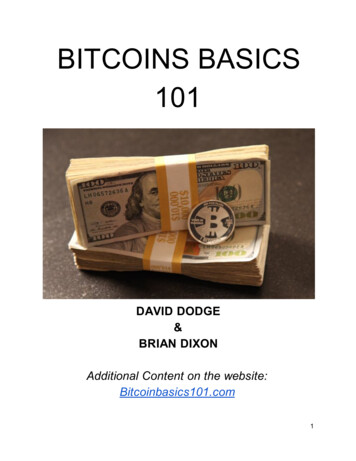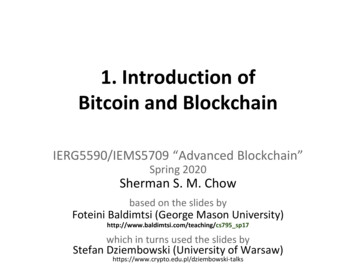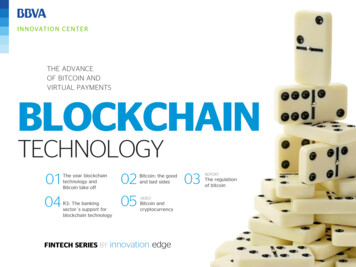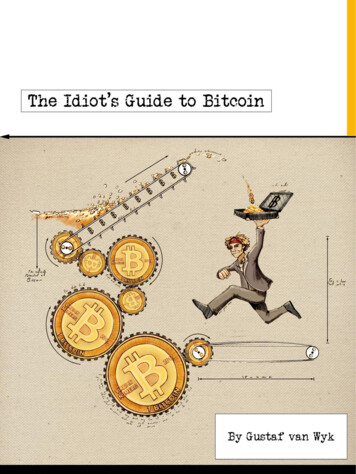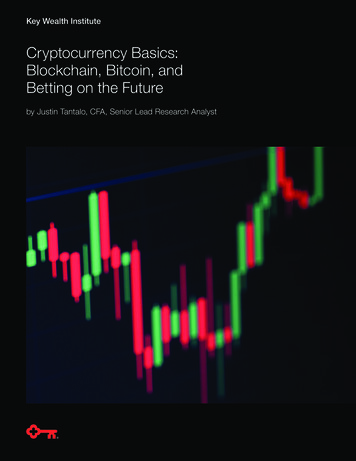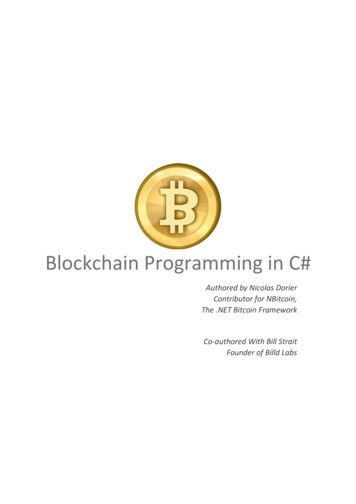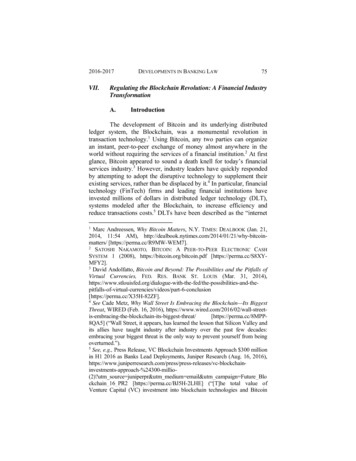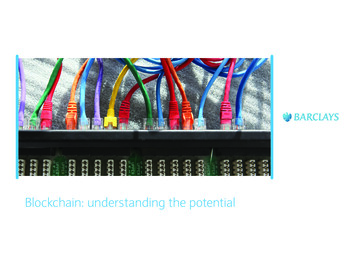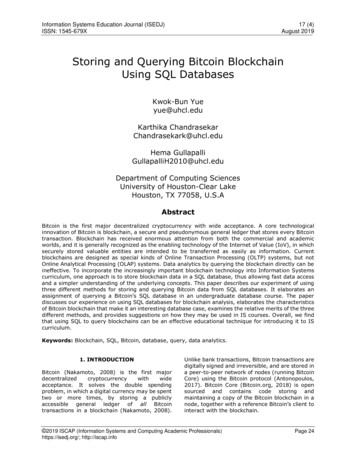
Transcription
Information Systems Education Journal (ISEDJ)ISSN: 1545-679X17 (4)August 2019Storing and Querying Bitcoin BlockchainUsing SQL DatabasesKwok-Bun Yueyue@uhcl.eduKarthika ChandrasekarChandrasekark@uhcl.eduHema GullapalliGullapalliH2010@uhcl.eduDepartment of Computing SciencesUniversity of Houston-Clear LakeHouston, TX 77058, U.S.AAbstractBitcoin is the first major decentralized cryptocurrency with wide acceptance. A core technologicalinnovation of Bitcoin is blockchain, a secure and pseudonymous general ledger that stores every Bitcointransaction. Blockchain has received enormous attention from both the commercial and academicworlds, and it is generally recognized as the enabling technology of the Internet of Value (IoV), in whichsecurely stored valuable entities are intended to be transferred as easily as information. Currentblockchains are designed as special kinds of Online Transaction Processing (OLTP) systems, but notOnline Analytical Processing (OLAP) systems. Data analytics by querying the blockchain directly can beineffective. To incorporate the increasingly important blockchain technology into Information Systemscurriculum, one approach is to store blockchain data in a SQL database, thus allowing fast data accessand a simpler understanding of the underlying concepts. This paper describes our experiment of usingthree different methods for storing and querying Bitcoin data from SQL databases. It elaborates anassignment of querying a Bitcoin’s SQL database in an undergraduate database course. The paperdiscusses our experience on using SQL databases for blockchain analysis, elaborates the characteristicsof Bitcoin blockchain that make it an interesting database case, examines the relative merits of the threedifferent methods, and provides suggestions on how they may be used in IS courses. Overall, we findthat using SQL to query blockchains can be an effective educational technique for introducing it to IScurriculum.Keywords: Blockchain, SQL, Bitcoin, database, query, data analytics.1. INTRODUCTIONBitcoin (Nakamoto, 2008) is the first . It solves the double spendingproblem, in which a digital currency may be spenttwo or more times, by storing a publiclyaccessible general ledger of all Bitcointransactions in a blockchain (Nakamoto, 2008).Unlike bank transactions, Bitcoin transactions aredigitally signed and irreversible, and are stored ina peer-to-peer network of nodes (running BitcoinCore) using the Bitcoin protocol (Antonopoulos,2017). Bitcoin Core (Bitcoin.org, 2018) is opensourced and contains code storing andmaintaining a copy of the Bitcoin blockchain in anode, together with a reference Bitcoin’s client tointeract with the blockchain. 2019 ISCAP (Information Systems and Computing Academic Professionals)https://isedj.org/; http://iscap.infoPage 24
Information Systems Education Journal (ISEDJ)ISSN: 1545-679XAlthough considered as behaving more like aspeculative investment than a currency by many(Yermack, 2015; Detrixhe, 2018), Bitcoin hasstormed into public awareness, reaching ahistorical peak price of 17,900 on December 15,2017 (Wikipedia, 2018). Table 1 contains acollection of some vital Bitcoin parameters on1/15/2019 11:00am central time to provide anillustrative snapshot. The data is collected fromvarious public websites, including blockchain.info,bitnodes.earn.com, and bitcoinblockhalf.com.Some parameters will be explained later inSection 2. As of January 2019, the current size ofthe Bitcoin blockchain is more than 199GB and itstores all of the more than 373 million of Bitcointransactions. With an all-time high marketcapitalization of 281 billion reached in December2018 seemingly pulling out of thin air, no wonderBitcoin has caught the imagination of the public.Number of Bitcoin nodesNumber of Bitcoins minedBitcoin’s priceBitcoin’s marketcapitalizationBitcoin blockchain’s sizeLatest blockNumber of transactions inthe latest blockEstimated transactionvolume in the latest blockTotal transaction fees inthe latest blockTotal number of allBitcoin transactionsDifficulty level10,17617,483,325(83.25% of total) 3,632 coin (BTC)0.14961742 BTC373.2 millions5,883,988,430,955321,592Number of transactions inthe last 24 hoursNumber of unspent60,947,620transaction outputsTable 1. A snapshot of Bitcoin’s Parameterson 1/15/2019 11:00am central encies, called altcoins, which numberedin 1,565 as of April 20, 2018 (Wikipedia 2018b).Even so, many consider that the blockchaintechnology developed and validated by Bitcoinmay be much more important than Bitcoin itself(Tucker, 2018). Bitcoin blockchain can beconsidered as the first generation of blockchainthat stores a specific cryptocurrency. Current andfuture generations of blockchains advance inmany directions (Zheng, et al., 2017).17 (4)August 2019With the general ledgers of transactions nearlyimpossible to tamper with, blockchains can beextended to store any valuable property or assetbeyondcryptocurrency.Animportantadvancement is the introduction of richprogramming languages and stateful blockchainsto allow the constructions of smart softwarecontracts to govern transaction completion, suchas the approach taken by Ethereum (2018), thesecond most popular cryptocurrency. Another keydevelopment is permissioned blockchains, suchas Hyperledger’s fabric (Androulaki, et al., 2018).Unlike public blockchain such as Bitcoin in s allow only a set of known andidentified participants, who shared a commongoals but do not fully trust each other. This enableprivate and federated blockchains (Zheng, et al.,2017).Tapscott, & Tapscott (2017a) indicate thatblockchain technology enables businesses withthe Internet of Value (IoV): “a secure platform,ledger, or database where buyers and sellerscould store and exchange value without the needfor traditional intermediaries.” The results can bedrastically reduced transaction cost and frictionthat disrupts the usual ways of conductingbusinesses in a wide spectrum of areas. Usinghigher education as an example, blockchainallows a Web of decentralized transactions,possibly enabling huge changes in keepingstudent records, optimizing student loanmanagement, improving pedagogy, incubatingmeta-universities, and ultimately creating aglobal network of learning institutes (Tapscott &Tapscott, 2017b). However, it is worthy to notethat like many other leading edge technology,blockchains come with risks and costs (forexample, see Walch, 2015).Despite its importance, information systems (IS)research in blockchain is just beginning to emerge(Beck, Avital, Rossi & Thatcher, 2017). In ISeducation, blockchain can be relevant to manycourses, including technical topics such ascomputer security, data analytics, echnology, etc. There are very few papers onincorporatingblockchaintechnologyininformation systems and computing courses,especially in the lower level. An exception is(Delmolino, et al., 2016) that describes theexperience of safe smart contract developmentlaboratories in a security class. There is a gapbetween the importance of blockchain, and itsexisting body of knowledge and results in ISeducation. For example, the 2017 EDSIG 2019 ISCAP (Information Systems and Computing Academic Professionals)https://isedj.org/; http://iscap.infoPage 25
Information Systems Education Journal (ISEDJ)ISSN: 1545-679Xconference provided a workshop on “the EasyWay to Create a Blockchain using FabricComposer” (Foley & Decker, 2017) in an effort tobridge the gap. This paper aims to contribute infilling this gap by describing our experience withstoring and querying Bitcoin blockchain using SQLdatabases. It is possible that other popularblockchains, such as Ethereum, can be used forthe same purpose of experimentation withblockchain. However, we selected Bitocin since itis the most popular public blockchain with toolswidely available.The rest of the paper is structured as follows.Section 2 discusses the basics of Bitcoin and itsblockchain, and the goals of this work as thebackground context. Section 3 examines threemethods of accessing Bitcoin data from SQLdatabases. Section 4 describes a Bitcoin’s SQLquery assignment in an undergraduate databasecourse and the accompanying surveys. Section 5discusses our experience using SQL to query theBitcoin blockchain. It describes the characteristicsthat make it an interesting database case, andprovides suggestions on how these differentmethods can be adopted in IS courses. Section 6discusses future directions and draws ourconclusions.2. BACKGROUND2.1 Bitcoin Blockchain and TransactionsBitcoin blockchain stores the entire history ofBitcoin transactions. A transaction stores thetransfers of Bitcoins (in the unit of Satoshi, with1 Bitcoin (BTC) 100,000,000 Satoshi) frominput accounts to output accounts, plusauthorization and other information. Bitcoinaccount addresses are public key hash values thatcan be authenticated by the correspondingprivate keys. Users can use a Bitcoin wallet tomanage their Bitcoin accounts (public keyhashes) and interact with the Bitcoin blockchain.Unlike a bank transaction transferring moneyfrom one account to another account, Bitcointransactions allow multiple inputs and multipleoutputs. Figure 1 shows four historicallyinteresting Bitcoin transactions. Figure 1a is thevery first Bitcoin transaction as 50 BTC went DivfNa’, whichis assumed to be controlled by Satoshi Nakamoto,the mysterious Bitcoin’s inventor(s). Bitcoinblockchain is known to be pseudonymous as alltransactions are publicly accessible but theownerships of accounts are anonymous within theblockchain. Many Websites provide Web pages17 (4)August 2019and APIs to access Bitcoin’s data in variousformats such as HTML, JSON or XML. Forexample, one can copy and paste Bitcoinaddresses, transaction hash addresses, or blockaddresses from this paper into the popular site,Blockchain.info. Figure 2 shows a part of theoutput page of Blockchain.info for the Bitcointransaction of Figure 1a.Transactions are grouped in blocks. For example,Table 1 indicates that the block #558,665 has2,854 transactions. The first Bitcoin transaction,called the genesis transaction here, is included inthe first block (known as the Genesis Block orBlock #0) as shown in Figure 1a. It is known as aCoinbase transaction to reward 50 BTC to theBitcoin miner who had successfully created theblock. Since the reward is created out of nowhereby Bitcoin, there is no input in a Coinbasetransaction. Bitcoin mining involves finding asmall enough block hash of the 80 Bytes headerof the new block. The required smallness, ordifficulty level, of the block hash is adjusted every2,016 blocks to ensure that every block is minedin about 10 minutes. The difficulty level of5,883,988,430,955 in Table 1 indicates adifficulty level of more than 5 trillion times asdifficult as that of the Genesis block. The 80 Byteblock header contains the hash of the Merkle treewhich is constructed from the hashes (addresses)of all transactions, ensuring that transactionscannot be changed. The block header alsocontains the previous block hash and thus theblock is chained together. Changing a block willchange its block hash, and any subsequent blockhashes will needed to be recomputed. Thisensures that the blockchain is nearly impossibleto tamper with.Unlike a bank that keeps the balance of everyaccount, Bitcoin blockchain keeps track of everytransaction, including those transaction outputs(TXOut) that have not yet been spent, which areknown as unspent transaction outputs (UTXO).UTXO can be used for future transaction inputs(TXIn). Note that in Figure 2, the transactionoutput of the Genesis block is still an UTXO. Thus,the very first Bitcoins generated has not yet beenspent, probably intentionally.Figure 1b shows another famous e16c5cf302fc80e9d5fbf5d48d,thefirstdocumented purchase of a good with Bitcoin inwhich 10,000 BTC was used to buy two Domino’spizzas on May 17, 2010. This pizza transactionhas one TXOut (presumably going to an accountowned by the pizza provider). Note that the buyergathered together 131 UTXO from previous 2019 ISCAP (Information Systems and Computing Academic Professionals)https://isedj.org/; http://iscap.infoPage 26
Information Systems Education Journal (ISEDJ)ISSN: 1545-679Xtransactions as TXIn to pool together 10,000.99BTC. This paid the 10,000 BTC to the TXOut, andthe transaction fee of 0.99BTC, which wascollected by the block miner together with the 50BTC mining reward. After the transaction wasconfirmed, these 131 UTXO were recorded asspent and can no longer be used as inputs toother transactions, thus solving the doublespending problem. The current approximate60,947,620 UTXO indicated in Table 1 is how thecurrent Bitcoins are ‘stored.’Figure 1c shows how the 10,000 BTC were usedby the ‘pizza person’ to provide for two TXOut inatransactioncalledthepizza-providertransaction here. Again, after this transaction, thepreviously unspent TXO to the pizza person with10,000 BTC was recorded as spent.In general, transactions can have multiple inputsand multiple outputs. Figure 1d shows the oldestBitcoin transaction with three TXIn and two TXOutsuch that one TXOut address is also a e241376a93825c1d6248a304ae693060b3007a43f2). The sendergathered three UTXO in his accounts, each with50 BTC. One TXOut received 105 BTC, and thechange of 44.74 BTC, after 0.26 BTC huWSBrB7D4W5XsTY53N1zY,which is one of the input addresses owned by thesender. We refer to this transaction as the 3i2ochange transaction.2.2 Purpose of InvestigationThe technical details of Bitcoins are quitecomplicated and tedious. Much of the complexityof Bitcoins is owed to the complex decentralizedand secure ledger structure, performancerequirements, and constant evolutions of theBitcoin software and protocol to solve emergingproblems. In a sense, Bitcoin is a giant ncydevelopersandblockchainengineers, need to know many of these low-leveland tedious complexity. For IS education, moststudents only need to know the basic blockchainstructure, which can be modeled in a high levelas containing a sequence of blocks oftransactions, with each transaction havingpossibly multiple TXIn and TXOut, in which anUTXO from a previous transaction is used as thesource for a TXIn (see Figure 3). Many IS coursesmay only need to use this high level model.Blockchains make very good cases for datascience and analytics courses. For example, onemay search using the keywords ‘blockchain’ or17 (4)August 2019‘bitcoin’ in the leading data science and analyticssite Kaggle (2018), and find vibrant communitieswith a large collection of datasets and kernels.However, current blockchains are designedmostly as special kinds of Online TransactionProcessing (OLTP) systems, but not OnlineAnalytical Processing (OLAP) systems. Dataanalytics by querying the blockchain directly,such as using the reference Bitcoin’s client, canbe ineffective (Anh, et al., 2018). Although manyWebsites provide services for querying Bitcoinblockchain, they are mostly limited by their usagepolicies and interfaces, and can be effective onlyfor small queries that do not process a largenumbers of transactions. Furthermore, the resultformats may not be suitable for analytics.Therefore, there are much activity on extractingdata from Bitcoin for storage in databases thatcan provide efficient accessing. For example,McGinn, McIlwraith & Guo (2018) and Spagnuolo,Maggi & Zanero (2014) both used Neo4j, an opensource graphical database. In this work, we selectto use SQL databases to construct examples andassignments for accessing, querying, andanalyzing Bitcoin. SQL is a high level declarativelanguage that is relatively easy to learn. Studentswith some database background should befamiliar with it. With highly available SQLdevelopers, it has become a de facto standardeven for many non-relational databases. Forexample, in Big Data technologies, HiveQL is aSQL-like declarative language of Hive forMapReduce (Thusoo, et al., 2010), and SparkSQL is a SQL dialect on top of Spark (Armbrust,et al., 2015). Similarly, cloud computingplatforms also embrace SQL, such as BigQuery byGoogle (2018a), which supports an extension ofstandard SQL. Thus, our purpose is to investigateusing SQL databases in IS courses for queryingblockchains.3. ACCESSING BITCOIN DATA WITH SQLThis section describes three methods we haveinvestigated: Abe-Bitcoin, BigQuery’s Bitcoin, andblockchainsql.io (bcsql). We identified a collectionof query problems for Bitcoin and developedsolutions on these methods as a practical way toexamine them for suitability of settingassignments. The near term goal was to identifya suitable platform for assignments in anundergraduate database course.3.1 A Local Bitcoin SQL DatabaseStoring the Bitcoin blockchain in a local SQLdatabase allows full control and customization tosatisfy diverse needs. Bitcoin blockchain is anappend-only database in which the only change 2019 ISCAP (Information Systems and Computing Academic Professionals)https://isedj.org/; http://iscap.infoPage 27
Information Systems Education Journal (ISEDJ)ISSN: 1545-679Xoccurs about every ten minutes when a new blockis created. Blocks are stored by Bitcoin Core indata files that do not change (except for the mostrecent evolving one) and can be parsed topopulate a SQL database. There are availableopen source Bitcoin SQL database options, suchas Abe (2018) and Bitcoin Database Generator(2018). We selected Abe because it capturesmore blockchain data, is more popular, and canalso be used to store a number of othercryptocurrencies.To install Abe, it is necessary to install BitcoinCore to obtain a local copy of the blockchain first.Depending on the connection bandwidth andcomputer configuration, it may take a few hoursto a few weeks to fully synchronize with theBitcoin network. We selected Postgres 9.6 toinstall Abe because it has good performanceproperties and provides many modern SQLconstructs. Abe is still in an Alpha version and wehad to overcome a few technical issues.Eventually, the installation was complete but ittook many days to do so in an old notebook.Partial ER diagrams of the three methods areshown in Figure 4 in Appendix 1. Table 2 showssome of their basic parameters. Abe has 17 tablesand 4 views. It is designed to be flexible enoughto handle multiple cryptocurrencies. Many tablesdo not have derived columns that are computedand stored for efficiency. For example, the tabletxin(txin id,tx id,txin pos,txout id,txin scriptsig, txin sequence) stores informationabout transaction input. The field txin id servesas a surrogate primary key, and tx id andtxout id are foreign keys referencing thetransaction containing the txid, and the txoutused for the TXIn respectively. The other threecolumns are basic raw data. Users accessing aTXIn usually needs more than raw basic data andAbe uses a view txin detail, which has 21columns to provide contextual and summary datafor the TXIn.Abe BigQuerybcsql# tables17213# views400# stored derived5015columnsTable 2 Some Parameters of the Three DBTo provide some ideas of how queries can beconstructed,considerthefollowingfourproblems, each related to an example transactionin Figure 1.1. Genesis transaction: find the (Genesis)block hash from the transaction hash.17 (4)August 20192. Pizza transaction: find the addresses andamounts of the TXIn from the pizzatransaction hash.3. Pizza-provider transaction: find the pizzaprovider transaction hash, its outputaddresses, and amounts that used theUTXO of the pizza transaction.4. 3i2o-changetransaction:findthetransaction hash of the first transactionwith 3 TXIn and 2 TXOut, and also with achange going back to one of the TXInaddresses.For reference, Appendix 2 lists the solutions tothese problems using Abe. During ourinvestigation, we found the relation schema ofAbe to be relatively easy to use and we were ableto construct solutions for a good collection ofinteresting query problems, some significantlymore complicated than the four examples here.However, there was a performance issue in Abethat can be crucial when used concurrently bymany students, especially since many of them arerelative novices. For example, the Abe’s solutionfor the pizza provider transaction in Appendix 2selects from six table instances, two of whichbeing of the table txout. It once took 143 ms toexecute in an old notebook. If we replace onetable instance of txout by the view txout detail,which provides additional contextual andsummary columns, the query only needs to selectfrom three more table instances, making thequery simpler. However, the execution timebecame 13 minutes. This is more serious in the3i2o-change problem. The solution in Appendix 2limits the solution space to the first 500transactions with three TXIn and the first 500transactions with two TXOut and hopes that theintersection of these two pools of transactionsincludes the result, which it does. Removing theselimits make the query not able to complete inhours. Thus, students submitting non-optimizedSQL queries can clog up the database. We arecurrently working on improving the performanceof Abe. Before its performance becomes moreacceptable, it is desirable to use other methodsfor setting the assignments.3.2 Through Cloud ComputingGoogle’s BigQuery is a cloud based enterprisedata warehouse platform for real time dataanalysis using SQL that is compliant to the SQL2011 standard and it has extensions for queryingnested data (Google, 2018a). Customers arecharged by the number of bytes of data processed(scan cost) and the first 1TB per month is free.Controlling costs by minimizing the volume of 2019 ISCAP (Information Systems and Computing Academic Professionals)https://isedj.org/; http://iscap.infoPage 28
Information Systems Education Journal (ISEDJ)ISSN: 1545-679Xdata processed of the query is a key concern incloud computing (Google, 2018b).BigQuery’s extensions to SQL allow columns tostore records and structures. Structures can beexpanded into tables by using the UNNESTfunction, which can then be used like derivedtables in the JOIN and SELECT clauses. Thus, itspublic Bitcoin’s dataset has only two tables:blocks and transactions, with internal structuresstored in columns. For examples, the many TXInand TXOut of a transaction are stored in thecolumns ‘inputs’ and ‘outputs’ of the transactionrespectively.BigQuery’s Bitcoin is designed mainly for fast dataanalytics using a columnar storage and treearchitecture (Sato, 2012). Bitcoin data is filteredand selectively stored in ways to facilitateanalysis for various kinds of analytic problems. Itis however not designed for exploring individualtransaction. The complexity for the solutions ofthe four problems is also higher since it does notgenerate a surrogate key for TXOut to easily linkTXIn to TXOut. Thus, we decided not to useBigQuery as the platform for our databaseassignments that usually contain mostly OLTPtype questions with some simple data analysisproblems.3.3 Through a Third Party Web InterfaceWe next investigated blockchainsql.io (2018),which contains a Web interface to submit SQLstatements to query its proprietary SQL Bitcoindatabase. Figure 5 shows a screenshot whereusers can submit queries or inspect the relationschema. It uses Microsoft SQL Server and has 13tables, with many stored derived columns toimprove performance. It is sufficiently fast for thelarge majority of the problems we prepared forthe problems, and students reported noperformance issues.Thus, with no setup and maintenance cost,reasonable performance, and ease of use, ourfirst pilot assignment used blockchainsql.io.However, it is worthy to point out its limitations.The instructor has no control of its availability,reliability, or interface, and can only use whateverdata the provider selects to provide. For example,the latest available block it provided on January2019 was #487,853 with a timestamp of “201709-06 16:23:23.” Thus, about 16 months of themost recent blocks were not available. Moreover,the output is in HTML and limited by the providerto 10 rows per page. It cannot be used easily asinput for further data analysis. Despite theselimitations, we found that blockchainsql.io is idealfor lightweight small database assignments.17 (4)August 20194. A BITCOIN’S SQL ASSIGNMENTWe experimented with an assignment on io in an undergraduate Introductionto Database course in Spring 2018. It ishomework #8 of a total of 10 assignments in thecourse. There was an earlier traditional SQLassignment. We gave a one hour lecture tointroducecryptocurrency,Bitcoin,andblockchain, but did not discuss blockchainsql.io asstudents were expected to explore it themselves.Studying and understanding existing relationschema is a course objective. Because of space,Appendix 3 shows only the core part of theassignment without the introductory ements.The objectives of the assignments are:1. Execute SQL statements via a third partyWeb interface.2. Study the relation schema of a newapplication: a Bitcoin SQL database.3. Gain insight on blockchain and Bitcoin.4. Gain some exposure on Microsoft SQLServer. (The course mainly used MySQL.)The assignment contains six query questionsranging from easy to beginning intermediate.Screenshots of expected output are provided withexplanations. Tips and suggestions are includedfor the more difficult questions mainly on thedifference between MySQL and MS SQL. Studentsneed to have a good understanding of therelational schema to answer the questions,especially the more difficult ones. As a reference,the suggested solutions are shown in Appendix 4.Before the lecture, a pre-assignment survey wasconducted with 25 respondents. It shows that twostudents have personally invested in Bitcoin and9 students have friends or family membersinvested in Bitcoin. This is a relatively highparticipation comparing to the general public.In a post-assignment survey, students wereasked about their perception on various aspectsof the assignments in a scale of 7 (1 signifyingstrong disagreement, 7 strong agreement, and 4neutral). The result is summarized in Table 3.Because of the small size of the sample, theseresults should only be considered to bepreliminary. No quantitative analysis has beenconducted. 2019 ISCAP (Information Systems and Computing Academic Professionals)https://isedj.org/; http://iscap.infoPage 29
Information Systems Education Journal (ISEDJ)ISSN: 1545-679XStatementAverage1. The assignment is useful.5.582. The assignment is interesting.6.003. The assignment is practical.5.524. The assignment helps me gain5.65experience on SQL executionthrough a Web interface.5. The assignment exposes me to5.81study the relational schema of anew application.6. The assignment helps me gain5.94insight on Bitcoin and blockchain.7. The assignment helps me to5.74gain experience on MS SQLServer.8. Overall, the assignment is5.55effective.Table 3. Post-Assignment Survey ResultsThe average responses range from 5.52 to 6.00,suggesting that the assignment is relativelyeffective in achieving its learning objectives. Thebest response is on Q2 Interestingness (6.00).This suggests that a timely assignment on aconfusing yet trending technology may beappealing. The response on Q3, help gaininginsight in Bitcoin and blockchain, is also high at5.94. This suggests this kind of assignments maybe useful not only in a database course, but alsoin courses directly targeting cryptocurrency andblockchain.We also asked two identical questions in both thepre-assignment and post-assignment surveys onthe student’s interest in Bitcoin and theirfamiliarity on its technical aspects. The averageresponses in a scale of 5 are shown in Table 4.PrePostDo you find Bitcoin3.363.94interesting?Are you familiar with the2.243.1technical aspects of Bitcoin?Table 4. Pre and post assignment surveysThere are marked improvements on bothindicators after the assignment. However, sincethere were two events, the one hour lecture andthe assignment, we do not know the portion ofcontribution from the assignment. Even withnearly no prior technical knowledge on Bitcoin,students seem to be doing fine in theassignments. The average grade for theassignment is 91.2, within the range of theaverage grades of 87.6 to 96.0 among the tenhomework assignments. Overall, the surveys canonly be considered as a pilot study but it points17 (4)August 2019to the potential of using SQL to query Bitcoinblockchain as an effective learning tool.5. DISCUSSIONAs the perceived enabling technology of IoV, thenext frontier in the advance of the Internet,blockchain is important in any forward looking IScurriculum. We discuss how blockchains can beincorporated into database courses as well asother IS courses in this section.5.1 Blockchain as Database CasesBitcoin is not only technologically interesting, butis also a very good general case study. It is hardto find another application with such a highmarket capitalization and all transactions publiclyaccessible. Blockchains also make very good casestudies for databases. Traditional databaseapplications provide four basic functions ofpersistent data: create, read, update, and delete(CRUD). Normalization theory in relationaldatabases aims at minimizing unnecessary dataredundancy to better maintain data consistencywhile writing to the database (Elmasri, &Navathe, 2010; Ricardo, 2015). However,normalization may create more relations,resulting in degraded performance. Thus, whenappropriate,theremaybeareverse,denormalization process
methods of accessing Bitcoin data from SQL databases. Section 4 describes a Bitcoin's SQL query assignment in an undergraduate database course and the accompanying surveys. Section 5 discusses our experience using SQL to query the Bitcoin blockchain. It describes the characteristics that make it an interesting database case, and
